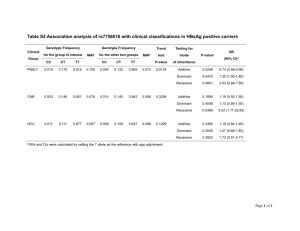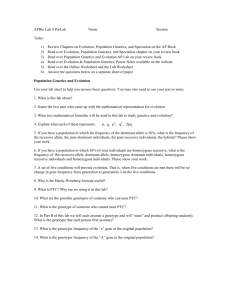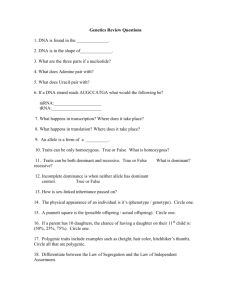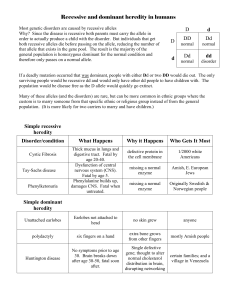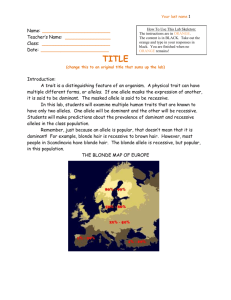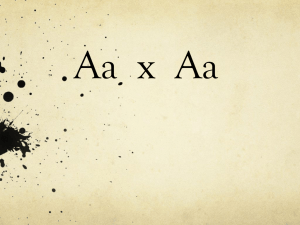Determining YOUR phenotype and genotype for various traits
advertisement
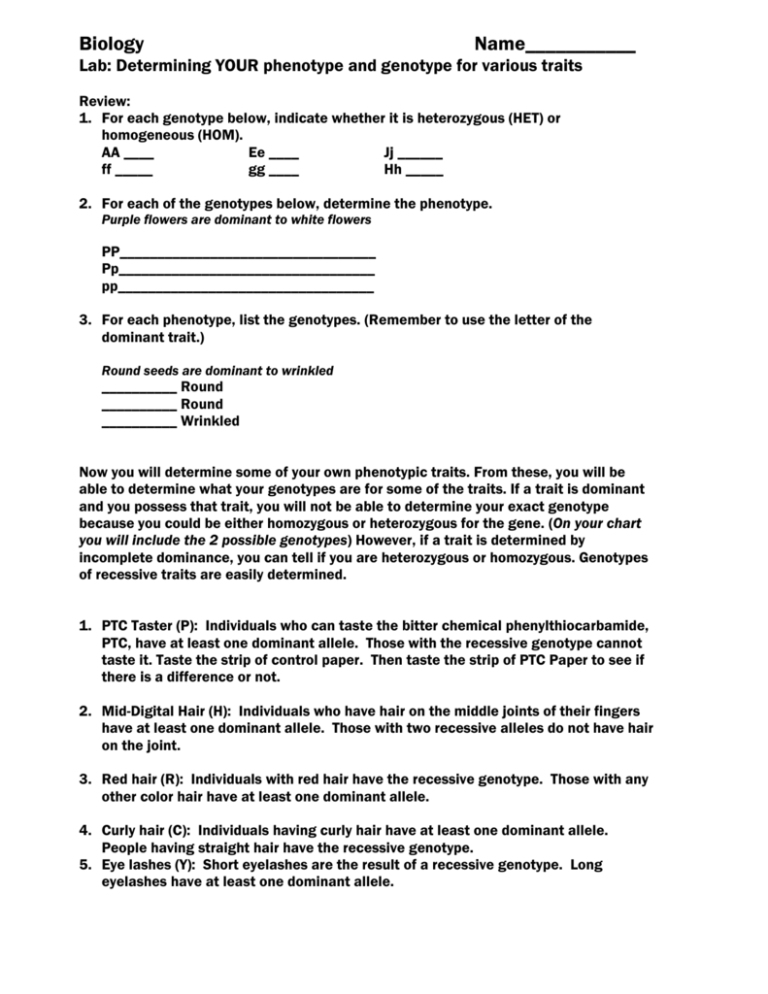
Biology Name___________ Lab: Determining YOUR phenotype and genotype for various traits Review: 1. For each genotype below, indicate whether it is heterozygous (HET) or homogeneous (HOM). AA ____ Ee ____ Jj ______ ff _____ gg ____ Hh _____ 2. For each of the genotypes below, determine the phenotype. Purple flowers are dominant to white flowers PP__________________________________ Pp__________________________________ pp__________________________________ 3. For each phenotype, list the genotypes. (Remember to use the letter of the dominant trait.) Round seeds are dominant to wrinkled __________ Round __________ Round __________ Wrinkled Now you will determine some of your own phenotypic traits. From these, you will be able to determine what your genotypes are for some of the traits. If a trait is dominant and you possess that trait, you will not be able to determine your exact genotype because you could be either homozygous or heterozygous for the gene. (On your chart you will include the 2 possible genotypes) However, if a trait is determined by incomplete dominance, you can tell if you are heterozygous or homozygous. Genotypes of recessive traits are easily determined. 1. PTC Taster (P): Individuals who can taste the bitter chemical phenylthiocarbamide, PTC, have at least one dominant allele. Those with the recessive genotype cannot taste it. Taste the strip of control paper. Then taste the strip of PTC Paper to see if there is a difference or not. 2. Mid-Digital Hair (H): Individuals who have hair on the middle joints of their fingers have at least one dominant allele. Those with two recessive alleles do not have hair on the joint. 3. Red hair (R): Individuals with red hair have the recessive genotype. Those with any other color hair have at least one dominant allele. 4. Curly hair (C): Individuals having curly hair have at least one dominant allele. People having straight hair have the recessive genotype. 5. Eye lashes (Y): Short eyelashes are the result of a recessive genotype. Long eyelashes have at least one dominant allele. 6. Freckles (K): The recessive genotype means the individual lacks freckles. An individual with freckles will have at least one dominant allele. 7. Dimples (D): An individual without dimples is homozygous recessive, while an individual with dimples has at least one dominant allele. 8. Cleft Chin (M): An individual with a genotype of homozygous recessive will have a cleft chin, while a person with at least one dominant allele will not have a cleft chin. 9. Hitchhiker’s thumb (J): A person that can bend the last joint of the thumb to approximately a 45 degree angle has the recessive genotype while an individual that cannot do it has at least one dominant allele. 10. Index Finger Length (I): If the index finger is shorter than the ring finger (4th finger next to the pinky), you have a dominant allele. If not, you have a recessive allele. 11. Ear lobes (E): Free ear lobes have at least one dominant allele. People with attached earlobes are recessive. 12. Widow’s Peak (W): A hairline that forms a downward point in the middle of the forehand is caused by a dominant allele. A smooth hairline is caused by a recessive genotype. 13. Tongue roller (T): A dominant allele gives some people the ability to roll their tongues into a “U” shape when it is extended. People with the recessive alleles cannot roll their tongues. 14. Tongue folder (F): A dominant allele gives some people the ability to fold their tongues over while sticking it out. People with the recessive genotype cannot. 15. Bent Little Finger (L): A dominant allele results in the end joint of the little finger of each hand bending inward. Straight little fingers are a result of the recessive genotype. Place your hands on a flat surface, palms down, and relax. Check to see if the first joints of your little fingers are bent or straight. Human Phenotypes and Genotypes Traits Recessive Dominant PTC taster Taster Non-taster Mid-digital hair Hair on middle joint No hair on middle joint Red hair All other hair colors Red hair Curly hair Curly Eye lashes Long Short Freckles Freckles No freckles Dimples Dimples No dimples Cleft chin No cleft chin Cleft chin Hitch-hiker’s thumb Can not bend 90o Can bend 90o Index finger length Index finger shorter than ring finger Earlobes Free earlobes Widow’s Peak Widow’s peak Tongue roller Can roll Index finger not shorter than ring finger Attached earlobes Smooth hairline Can’t roll Tongue folder Can fold Can’t fold Bent little finger Bent straight Wavy (Cc) straight Your phenotype Your possible Genotype(s) Monohybrid crosses Draw a Punnett square for each cross. 1. A person with attached earlobes is crossed with a person who is heterozygous for unattached earlobes. What chances that their children will have attached or unattached earlobes? 2. What offspring phenotypes would be expected in the following crosses: a) Homozygous PTC taster X Heterozygous PTC taster b) Non-taster X Heterozygous PTC taster c) If Mr. and Mrs. McClure have 3 children and one of them is a non-taster, what are the genotypes of Mr. and Mrs. McClure?
